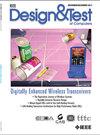Reliability Implications of NBTI in Digital Integrated Circuits
引用次数: 3
Abstract
Bias temperature instability (BTI) in MOSFETs in one of the major reliability challenges in nano-scale technology. This paper evaluates the severity of Negative BTI (NBTI) degradation in two major circuit applications: random logic and memory array. Simulation results obtained from 65nm PTM node shows that NBTI induced degradation in random logic is considerably lower than that of a single transistor. Simple delay guard-banding can efficiently mitigate the impact of NBTI in random logic. On the other hand, NBTI degradation in memories results in severe READ stability degradation, especially when combined with random process variation. Moreover, in scaled technology nodes, finite number of Si-H bonds in the channel can induce a statistical random variation in the degradation process. Simulations using 32nm/22nm Predictive Technology Model (PTM) shows that statistical random variation of NBTI, on top of random dopant fluctuation (RDF) results in significant random Vt variation in PMOS transistors, resulting in considerable degradation in static noise margin (SNM) of memory cells.数字集成电路中NBTI对可靠性的影响
mosfet的偏置温度不稳定性(BTI)是纳米级技术可靠性的主要挑战之一。本文评估了两种主要电路应用:随机逻辑和存储阵列中负BTI (NBTI)退化的严重程度。在65nm PTM节点上的仿真结果表明,NBTI引起的随机逻辑的退化比单晶体管低得多。简单的延迟保护带可以有效地减轻随机逻辑中NBTI的影响。另一方面,NBTI在记忆中的退化会导致严重的读稳定性下降,特别是当与随机过程变化结合时。此外,在缩放技术节点中,通道中有限数量的Si-H键会在降解过程中引起统计随机变化。基于32nm/22nm预测技术模型(PTM)的仿真结果表明,在随机掺杂波动(RDF)的基础上,NBTI的统计随机变化导致PMOS晶体管的随机Vt显著变化,导致存储单元的静态噪声余量(SNM)显著下降。
本文章由计算机程序翻译,如有差异,请以英文原文为准。
求助全文
约1分钟内获得全文
求助全文

 求助内容:
求助内容: 应助结果提醒方式:
应助结果提醒方式:


